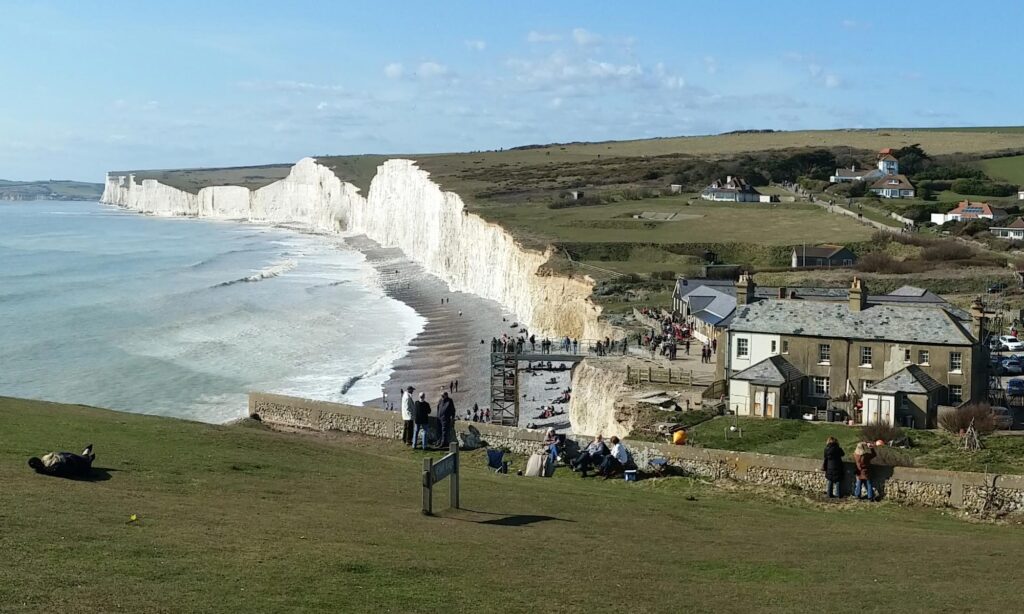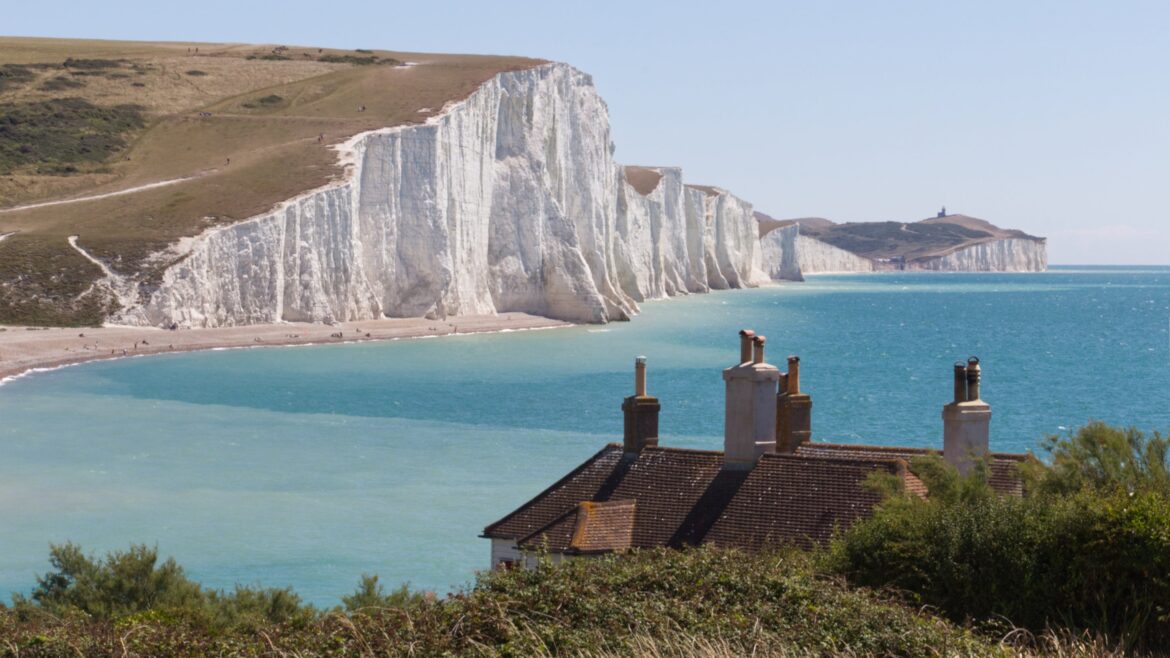On the southern coast of England, between Eastbourne and Seaford in East Sussex, lies one of the country’s most breathtaking and instantly recognisable coastal landscapes: Birling Gap and the Seven Sisters. Part of the South Downs National Park, this dramatic stretch of coastline is defined by rolling chalk hills plunging into the English Channel, sheer white cliffs glowing in the sunlight, and a constantly shifting shoreline shaped by the relentless force of erosion. Together, Birling Gap and the Seven Sisters embody the beauty, fragility, and cultural resonance of England’s seaside heritage.

The Seven Sisters: A Natural Wonder
The Seven Sisters are a series of chalk cliffs that stretch between Cuckmere Haven and Birling Gap. They are named for the seven distinct hilltops that rise and fall in a rhythmic sequence along the coast: Haven Brow, Short Brow, Rough Brow, Brass Point, Flat Hill, Baily’s Hill, and Went Hill Brow. Their gleaming white faces, carved from chalk laid down in the Late Cretaceous period over 80 million years ago, are a striking reminder of southern England’s geological past.
Unlike the White Cliffs of Dover, which have been somewhat discoloured by industry and urban development, the Seven Sisters remain brilliantly white, continually refreshed by erosion as the sea chips away at their bases and causes cliff falls. This process, while destructive in human terms, ensures the cliffs retain their iconic colour and appearance.
The Seven Sisters are not static; they are living cliffs in constant flux. The headlands retreat inland by around 30 to 40 centimetres each year on average, though in stormy seasons entire sections may collapse at once. This transience is part of their fascination: the cliffs we admire today will not exist in the same form in future decades, reminding us of the impermanence of landscapes.
Birling Gap: Gateway to the Cliffs
At the western end of the Seven Sisters lies Birling Gap, a small coastal hamlet and access point managed by the National Trust. Birling Gap provides one of the safest and most convenient routes down the cliffs, via a metal staircase leading to the beach below. For many visitors, this is the starting point for exploring the shoreline and appreciating the Seven Sisters from sea level, where their grandeur becomes even more apparent.
Birling Gap itself has long been shaped by the forces of erosion. The row of Victorian coastguard cottages perched near the cliff edge has gradually been reduced in number, as the sea claimed one house after another. The National Trust has made the difficult but pragmatic decision to allow nature to take its course here, accepting that the cliffs will continue to retreat and that human habitation at their edge cannot be sustained indefinitely.
The visitor centre at Birling Gap provides information on the area’s geology, history, and wildlife, as well as a café where walkers can rest after their explorations. For many, Birling Gap is a poignant place: a reminder of the raw power of the sea and the delicate balance between human presence and natural processes.
History and Human Connections
The Seven Sisters and Birling Gap have long held significance for those living along the Sussex coast. Historically, the cliffs were landmarks for sailors navigating the busy waters of the English Channel. The treacherous seas at their base, however, were notorious for shipwrecks. Smuggling was rife along this stretch of coast in the 18th and 19th centuries, with hidden coves providing shelter for illicit activities.
The coastguard cottages at Birling Gap were built to combat smuggling, housing officers whose duty was to intercept contraband and enforce customs laws. Over time, the cottages became symbols of Britain’s battle between the sea’s unpredictability and human determination to control it.
In the 20th century, the cliffs took on new significance during wartime. The headland offered strategic viewpoints during both World Wars, and nearby Beachy Head hosted radar stations crucial to Britain’s air defense. Today, remnants of wartime infrastructure can still be found in the area, a reminder of its role in national security.
Wildlife and Natural Beauty
Birling Gap and the Seven Sisters are not just visually stunning—they are also ecologically rich. The chalk grasslands atop the cliffs are a biodiversity hotspot, supporting wildflowers such as orchids, cowslips, and thrift. These plants, in turn, attract butterflies, bees, and other pollinators.
The cliffs themselves provide nesting sites for seabirds, including kittiwakes, fulmars, and peregrine falcons. At low tide, the beach at Birling Gap reveals rock pools teeming with marine life, from crabs and limpets to starfish and anemones. Offshore, seals are sometimes spotted, while the Channel occasionally sees dolphins and porpoises.
The National Trust works to conserve this delicate environment, balancing the needs of visitors with those of wildlife. Grazing sheep and cattle play a vital role in maintaining the grassland habitats, preventing scrub from encroaching on the wildflower meadows.
Walking and Recreation
For walkers, Birling Gap and the Seven Sisters are a paradise. The South Downs Way, one of England’s premier long-distance footpaths, runs across the clifftops, offering exhilarating views and fresh sea air. The undulating hills of the Seven Sisters make for a challenging but rewarding hike, each summit revealing new panoramas of sea and countryside.
The walk from Seaford to Eastbourne, passing over the Seven Sisters and Birling Gap, is often described as one of the most beautiful coastal walks in the world. It combines the raw grandeur of the cliffs with the tranquility of rural villages and the expansiveness of the South Downs.
For those who prefer gentler pursuits, the beach at Birling Gap provides opportunities for fossil hunting, exploring rock pools, or simply sitting and watching the waves. Artists and photographers are drawn to the cliffs for their stark contrasts of white chalk, green grass, and blue sea, which shift constantly with the light and weather.
Erosion and Climate Change
Erosion at Birling Gap and the Seven Sisters is both a natural and a pressing modern issue. While cliff falls have always been part of the landscape’s story, rising sea levels and stronger storms linked to climate change are accelerating the process. The retreat of the coastline is expected to continue, with predictions that much of Birling Gap village will eventually disappear into the sea.
The National Trust has adopted a policy of “managed retreat,” recognising that it is neither practical nor environmentally sustainable to halt erosion in such a dynamic landscape. Instead, the emphasis is on adapting to change, documenting the loss of built structures, and allowing the cliffs to evolve naturally. For visitors, this adds a bittersweet dimension: each visit may be the last time a particular view or building can be seen.
Cultural Significance
Birling Gap and the Seven Sisters have a strong presence in popular culture. Their cliffs have appeared in films, television shows, and even music videos, often symbolising England’s rugged beauty or serving as a metaphor for isolation, endurance, or change. They have been compared favourably to the White Cliffs of Dover, with some arguing that the Seven Sisters are more unspoiled and dramatic.
The area has also inspired poets, writers, and painters. Its sense of space, light, and impermanence resonates deeply with those who seek to capture the essence of the English landscape. For local communities, the cliffs are both a source of pride and a reminder of the forces that shape daily life along the coast.
Visiting Birling Gap and the Seven Sisters
For modern visitors, Birling Gap is one of the best access points to the cliffs. The National Trust provides parking, a visitor centre, and a café, while the metal steps down to the beach make it possible to experience the shoreline firsthand. Visitors must exercise caution, as cliff edges can be unstable and rock falls unpredictable. Staying on marked paths and keeping a safe distance from the edge are essential.
The best times to visit are often early morning or late afternoon, when the light is softer and crowds thinner. Sunset at Birling Gap can be spectacular, with the cliffs glowing in hues of pink and gold. For walkers undertaking the full Seven Sisters hike, good weather, sturdy shoes, and plenty of water are recommended.
Conclusion
Birling Gap and the Seven Sisters embody the essence of England’s southern coast: beauty and fragility, history and change, grandeur and impermanence. Their chalk cliffs, sculpted over millions of years, continue to evolve under the pressure of sea and wind. They remind us of the delicate balance between human presence and natural forces, and of the power of landscapes to inspire, humble, and move us.
Whether approached as a destination for walking, a site of natural wonder, or a cultural icon, Birling Gap and the Seven Sisters stand among Britain’s greatest treasures. For those who climb their hills, wander their beaches, or simply stand and gaze at their white faces shining against the sea, the memory of this extraordinary place lingers long after the visit ends.

